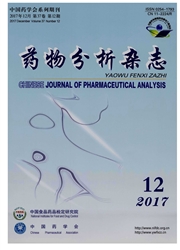

 中文摘要:
中文摘要:
目的:分析柑橘、油菜和紫云英蜜中的特征黄酮类组分。方法:采用UPLC—MS/MS同时分析油菜蜜、紫云英蜜和柑橘蜜及其蜜源花中的黄酮类组分。色谱柱采用Inertsil ODS-3柱(2.1mm×75mm,2μm),柱温40℃,以甲醇-0.02%甲酸为流动相梯度洗脱,流速为0.4mL·min-1;以儿茶酸、表儿茶酸、芦丁、芸香柚皮苷、桑黄素、杨梅素、山柰酚、生松素等16个黄酮类对照品作为对照,采用电喷雾离子源(ESI),多反应监测(MRM)进行分析。结果:不同蜜源蜂蜜中的特征黄酮类组分及其含量(从高到低排列)有所不同:柑橘蜜的特征组分有柚皮素、木犀草素、芹菜素和汉黄芩素;油菜花蜜的特征组分有柚皮素、槲皮素和汉黄芩素;紫云英蜜的特征组分有槲皮素、山柰酚、芹菜素和汉黄芩素。结论:该方法灵敏度高,以蜜源花作为“对照”寻找蜂蜜中的特征成分具有数据可靠、可溯源性,并对蜜源花中化学成分的分析具有指导意义。
 英文摘要:
英文摘要:
Objective: To analyze the characteristic flavonoids in citrus, canola flower and milk vetch honeys. Methods: The flavonoids in canola flower honey, milk vetch honey, citrus honey and their nectar flowers were simultaneously analyzed by UPLC-MS/MS. The samples were analyzed on an Inertsil ODS-3 column ( 2.1 mm×75mm,2μm ), eluted with methanol-0.02% formic acid solution as mobile phase in gradient mode at a flow rate of 0.4 mL min-1, the column temperature was controlled at 40 ℃ and the injection volume was 2 μL; electrospray ionization ( ESI ) source was applied and operated in the negtive or positive multiple reaction monitoring ( MRM ) mode, 16 flavonoids were used as reference, such as catechin, epicatechin, rutin, narirutin, morin, myricetin,kaempferol, pinocembrin etc. Results: The characteristic components and their contents ( from highest to lowest ) were different in different nectar honey: characteristic components in citrus honey were naringenin, luteolin, and apigenin wogonin; canola flower honey had naringenin, quercetin and Wogonin; and milk vetch honey had quercetin, kaempferol, apigenin and wogonin. Conclusion: The method with flowers as a "control" to find honey' s characteristic component is sensitive, reliable, and traceable. The developed method was helpful to analyze the chemical components in flower nectar.
 同期刊论文项目
同期刊论文项目
 同项目期刊论文
同项目期刊论文
 期刊信息
期刊信息
